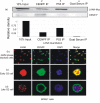Protein complexes associated with the Kaposi's sarcoma-associated herpesvirus-encoded LANA
- PMID: 17434559
- PMCID: PMC4067005
- DOI: 10.1016/j.virol.2007.03.010
Protein complexes associated with the Kaposi's sarcoma-associated herpesvirus-encoded LANA
Abstract
Kaposi's sarcoma-associated herpesvirus (KSHV) is the major biological cofactor contributing to development of Kaposi's sarcoma. KSHV establishes a latent infection in human B cells expressing the latency-associated nuclear antigen (LANA), a critical factor in the regulation of viral latency. LANA is known to modulate viral and cellular gene expression. We report here on some initial proteomic studies to identify cellular proteins associated with the amino and carboxy-terminal domains of LANA. The results of these studies show an association of known cellular proteins which support LANA functions and have identified additional LANA-associated proteins. These results provide new evidence for complexes involving LANA with a number of previously unreported functional classes of proteins including DNA polymerase, RNA helicase and cell cycle control proteins. The results also indicate that the amino terminus of LANA can interact with its carboxy-terminal domain. This interaction is potentially important for facilitating associations with other cell cycle regulatory proteins which include CENP-F identified in association with both the amino and carboxy-termini. These novel associations add to the diversity of LANA functions in relation to the maintenance of latency and subsequent transformation of KSHV infected cells.
Figures





Similar articles
-
Bub1 and CENP-F can contribute to Kaposi's sarcoma-associated herpesvirus genome persistence by targeting LANA to kinetochores.J Virol. 2010 Oct;84(19):9718-32. doi: 10.1128/JVI.00713-10. Epub 2010 Jul 21. J Virol. 2010. PMID: 20660191 Free PMC article.
-
Full-Length Isoforms of Kaposi's Sarcoma-Associated Herpesvirus Latency-Associated Nuclear Antigen Accumulate in the Cytoplasm of Cells Undergoing the Lytic Cycle of Replication.J Virol. 2017 Nov 30;91(24):e01532-17. doi: 10.1128/JVI.01532-17. Print 2017 Dec 15. J Virol. 2017. PMID: 28978712 Free PMC article.
-
Kaposi's sarcoma-associated herpesvirus-encoded LANA recruits topoisomerase IIβ for latent DNA replication of the terminal repeats.J Virol. 2012 Sep;86(18):9983-94. doi: 10.1128/JVI.00839-12. Epub 2012 Jul 3. J Virol. 2012. PMID: 22761383 Free PMC article.
-
The latency-associated nuclear antigen interacts with MeCP2 and nucleosomes through separate domains.J Virol. 2010 Mar;84(5):2318-30. doi: 10.1128/JVI.01097-09. Epub 2009 Dec 23. J Virol. 2010. PMID: 20032179 Free PMC article.
-
Kaposi's Sarcoma-Associated Herpesvirus Latency-Associated Nuclear Antigen: Replicating and Shielding Viral DNA during Viral Persistence.J Virol. 2017 Jun 26;91(14):e01083-16. doi: 10.1128/JVI.01083-16. Print 2017 Jul 15. J Virol. 2017. PMID: 28446671 Free PMC article. Review.
Cited by
-
H2AX phosphorylation is important for LANA-mediated Kaposi's sarcoma-associated herpesvirus episome persistence.J Virol. 2013 May;87(9):5255-69. doi: 10.1128/JVI.03575-12. Epub 2013 Feb 28. J Virol. 2013. PMID: 23449797 Free PMC article.
-
The malignant potential of HIV-associated Kaposi sarcoma.Cancer Cell Int. 2008 Oct 31;8:14. doi: 10.1186/1475-2867-8-14. Cancer Cell Int. 2008. PMID: 18976452 Free PMC article.
-
ARID3B: a Novel Regulator of the Kaposi's Sarcoma-Associated Herpesvirus Lytic Cycle.J Virol. 2016 Sep 29;90(20):9543-55. doi: 10.1128/JVI.03262-15. Print 2016 Oct 15. J Virol. 2016. PMID: 27512077 Free PMC article.
-
Kaposi's sarcoma herpesvirus upregulates Aurora A expression to promote p53 phosphorylation and ubiquitylation.PLoS Pathog. 2012;8(3):e1002566. doi: 10.1371/journal.ppat.1002566. Epub 2012 Mar 1. PLoS Pathog. 2012. PMID: 22396649 Free PMC article.
-
Application of proteomics to soft tissue sarcomas.Int J Proteomics. 2012;2012:876401. doi: 10.1155/2012/876401. Epub 2012 Jun 19. Int J Proteomics. 2012. PMID: 22778956 Free PMC article.
References
-
- Ackermann M. Pathogenesis of gammaherpesvirus infections. Vet Microbiol. 2006;113(3-4):211–22. - PubMed
-
- An J, Lichtenstein AK, Brent G, Rettig MB. The Kaposi sarcoma-associated herpesvirus (KSHV) induces cellular interleukin 6 expression: role of the KSHV latency-associated nuclear antigen and the AP1 response element. Blood. 2002;99(2):649–54. - PubMed
-
- Bajaj BG, Verma SC, Lan K, Cotter MA, Woodman ZL, Robertson ES. KSHV encoded LANA upregulates Pim-1 and is a substrate for its kinase activity. Virology. 2006;351(1):18–28. - PubMed
-
- Ballestas ME, Chatis PA, Kaye KM. Efficient persistence of extrachromosomal KSHV DNA mediated by latency-associated nuclear antigen. Science. 1999;284(5414):641–4. - PubMed
Publication types
MeSH terms
Substances
Grants and funding
- R01 DE014136/DE/NIDCR NIH HHS/United States
- CA108461/CA/NCI NIH HHS/United States
- DE017338/DE/NIDCR NIH HHS/United States
- AI067037/AI/NIAID NIH HHS/United States
- R01 DE017338/DE/NIDCR NIH HHS/United States
- R01 CA108461/CA/NCI NIH HHS/United States
- CA072510/CA/NCI NIH HHS/United States
- DE01436/DE/NIDCR NIH HHS/United States
- R01 CA091792/CA/NCI NIH HHS/United States
- R01 CA072150/CA/NCI NIH HHS/United States
- CA091792/CA/NCI NIH HHS/United States
- R29 CA072150/CA/NCI NIH HHS/United States
- R01 AI067037/AI/NIAID NIH HHS/United States
LinkOut - more resources
Full Text Sources

